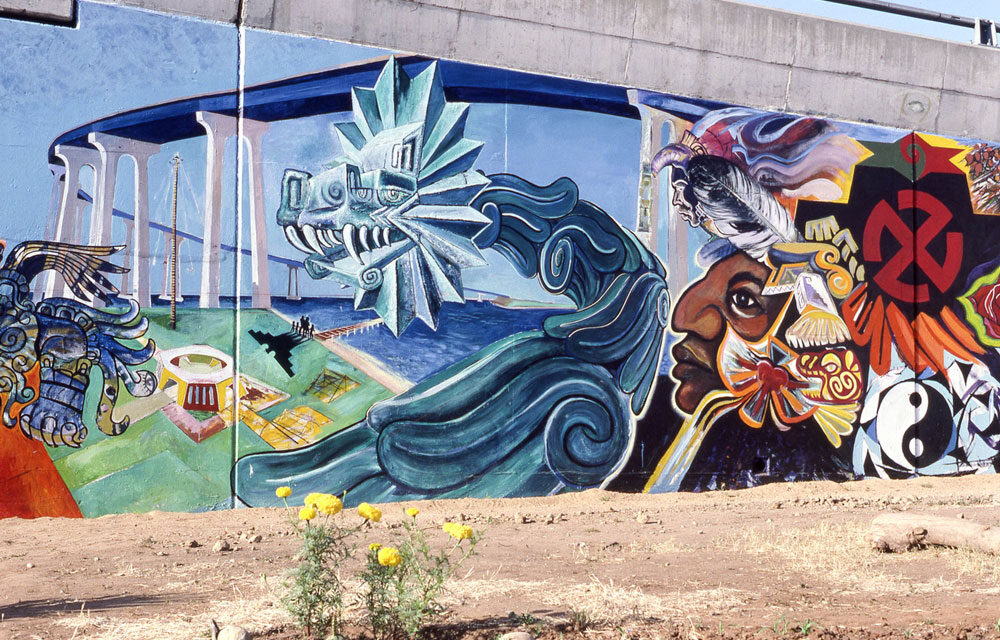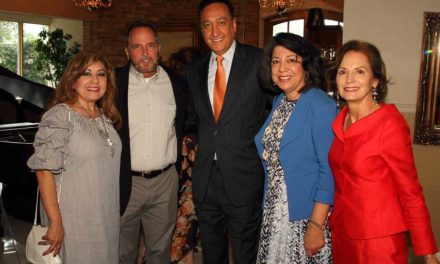An exciting new exhibition, Son de Allá y Son de Acá, [They are from there and they are from here], opens on October 7th, 2023 at the new Chicano Park Museum and Cultural Center in San Diego, California. The curators Ricardo Islas [San Diego], Rigoberto Luna [San Antonio], and Vicente Telles [Albuquerque] worked closely with Christian Ramírez, Assistant Curator of Contemporary and Community Art Initiatives at the Phoenix Art Museum to “showcase contemporary art that transcends boundaries and celebrates the cultural diversity of the American Southwest.” Luna, Director of Presa House in San Antonio, and his colleagues invite viewers to experience the vibrant art created in borderland communities of
Arizona, California, New Mexico, and Texas.
The Chicano Park Museum and Cultural Center in San Diego, California opened in Barrio Logan on October 8, 2022, fifty-three years after the founding of Chicano Park. The struggle to erect a community park in Barrio Logan began in 1970, a monumental and dramatic Chicano history story. In the Spring of 1970, an extraordinary community crisis arose when bulldozers showed up to clear the land for a seven-acre parking addition for California patrol cars. Alarmed at losing their sole community space, Latino activists and residents peacefully surrounded the construction site. Their determined action pitted hundreds of Barrio Logan residents against the powerful Highway Patrol. After a twelve-day standoff, State officials relented, and the park was turned over to the community, fulfilling a promise that state officials had made ten years earlier.
Community artists led by Salvador Torres, David Avalos, and Yolanda Lopez proposed that Chicano murals be painted on the tall concrete pillars and panels supporting a new bridge to Coronado Island. Their recommendation contributed to the beginning of the Chicano mural movement, which had its U.S. origins in Southern California. With the acquisition of Chicano Park, artists had ample access to large spatial areas to
complete their creative projects. Following fifty years of continuous painting, Chicano Park artists describe their artistic achievement today as the largest concentration of Chicano murals in the world.
The San Diego and Los Angeles art movements had an enormous American art impact triggering the advent of the mural movement across the country. As a member of the History Department at the University of California at
San Diego in 1974, I had the opportunity to witness this new art movement in the making. A year after the
completion of the first series of murals at Chicano Park, I became Board Chair of the Centro Cultural de la Raza in nearby Balboa Park. The Centro invited artists from Chicano Park to paint large 30-foot-high murals on the inside and outside walls of the Centro’s refurbished water tower building.
The 45 participants in the Son de Allá y Son de Acá exhibit are contributing to the rise of a new generation of artists who take a serious look at the borderland experience in developing the conceptional imagery of their work. Gloria Martinez-Granados, a Phoenix, Arizona artist, for example, incorporates her experience as an undocumented immigrant into her paintings.
Gloria Martinez-Granados’s early life was not easy. She migrated at an early age with her family from Guanajuato, Mexico to the United States. Writing for the Arizona Republic, Raphael Romero Ruiz commented that Martinez-Granados “uses her art to call out and to bring awareness to the plight [of immigrants] in her
community.” In recent works, the artist has focused on the DACA program and how it impacts college students and young workers.
Jesus Trevino, a native of Brownsville, Texas deals with the complex issues surrounding the “erasure of history, displacement of people, and its residual personal, emotional, and social effects.” Trevino finds inspiration in everyday ordinary borderland experiences. In one painting, he captures conjunto musicians playing the accordion accompanied by a guitar player and singer. Several of his paintings include the ever-present nopales or green cactus plants common to the borderland region. One of my favorites in the show is a painting of a middle-aged couple dancing on a basketball court late at night.
Ricardo Islas, one of the exhibit curators, grew up in Calexico, California, a border town two hours east of San Diego. Islas paints the daily lives of Mexicans and Chicanos of the borderlands. He is profoundly committed to interpreting their experiences in a social and cultural context.
In several of his paintings, Islas addressed
gentrification which has caused barrio housing displacement in San Diego. He referred to the Chicano Park struggle in 1970 as the earliest gentrification fight mounted by Latinos in his hometown. Islas’s painting, “Our Barrio is not For Sale,” speaks to a modern episode of displacement in his community. Islas credits Jose Clemente Orozco, Frida Kahlo, and Francisco Goya for his artistic inspiration.
Exhibit curator Vicente Telles, also an artist, was responsible for locating and selecting most of the New Mexico artists. In many of his paintings, Telles includes both conceptual and realistic renderings. One painting features a jug of water filled with Van Gogh-style sunflowers. Telles noted that there is tragedy associated with the imagery. The painting represents the jugs of water people left for migrants crossing the deserts of Northern Mexico into the United States. Telles heard many stories of these jugs of water that often saved lives. The jugs, however, were usually found kicked over and
punctured to deprive an immigrant of water.
Brandon Maldonado, like Telles, grew up in
Albuquerque, New Mexico. Primarily a self-taught artist, Maldonado’s initial observations of Latino art came about in his early teens when he began to notice the graffiti art of his barrio community. He strongly believes that philosophy and religion have been especially influential in what Latinos painted and how and why it is painted.
Maldonado acknowledged a fascination with the history and culture of the borderlands along with ”its living and historical ties to the story of Mexico and its Mestizo legacy.” Regarding his art, he stated: “I feel like a cook in the kitchen throwing ingredients in the gumbo. A dash of Picasso-esque cubism sprinkled atop traditional New Mexican retablo folk-art aesthetics and a hefty helping of the hypnotic repetitious patterning of celebrated outside artist Martin Ramirez.”
Born and raised in Southeast San Diego,
Jazmine Puentes focuses on what she terms the ‘internal development and complexities of
self-transformation” that have been a part of the many difficulties in her lifetime. Inspired by cultural beliefs, she releases internal “feelings of emotions by creating
stories into illustrations and paintings that carry significant meaning with an exploration of vibrant colors.”
In Puentes’s painting “Amor Eterno” a young infant lies with her eyes closed. Given the title, one wonders if the infant is alive. The brilliant songwriter and singer Juan Gabriel wrote his most well-known Mexican borderland song “Amor Eterno” representing universal themes of love and loss. Mariachis sing this song at many Mexican and borderland funerals.
In Puentes’s painting, a young infant is
surrounded by animals and plants, images commonly found in many of the artist’s works. Puentes takes a different approach to the Mexican song title. She commented that she “wanted to create a painting pouring every emotion felt since her birth” portraying a child whom she identifies as her niece. Puentes noted that the infant is “asleep & dreaming while hummingbirds are welcoming her into the world.” The artist explained that hummingbirds “represent the spirits of ancestors and loved ones always protecting her even from a different realm.”
Chicano Park Museum in San Diego Opens Exhibit Son de Allá y Son de Acá with Forty-Five Latino Artists











Congratulations to all the artists. Proud of my sister Jazmine Puentes. It is an amazing exhibit! Definitely stop by when you’re in San Diego.